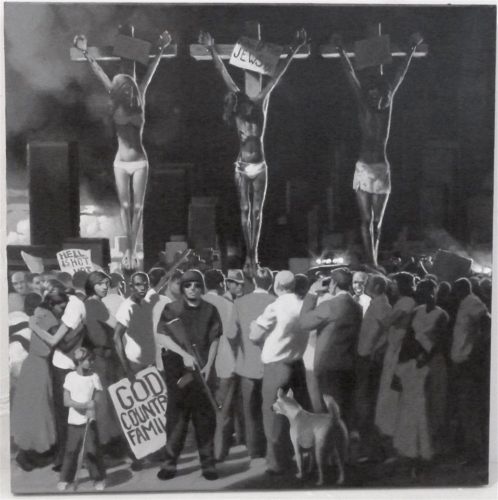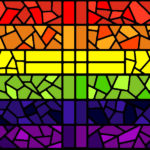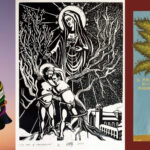Last Updated on April 11, 2025 by Kittredge Cherry

“While the sun’s light failed… he breathed his last.” — Luke 23:44-46
“Jesus Dies” places Christ’s crucifixion against a 21st-century city skyline in “The Passion of Christ: A Gay Vision,” a series of 24 paintings by Douglas Blanchard. The art and reflections are also available as a book and prints. Jesus hangs on modern scaffolding that forms a cross behind him. He dies an outcast’s death in pain and humiliation. Jesus stayed true to his vision, even when it brought him into conflict with authorities, even to the point of death. Head bowed, Jesus looks like a corpse. Storm clouds blot out the sun in the sky above. The body of Christ dwarfs the crowd in the background. Some jeer at the dead martyr while others pray. Many, including a few priests, watch grimly. Once again Jesus has brought together an unlikely group. These spectators look like ordinary people today, becoming a visual counterpart to the African American spiritual that asks, “Were you there?”
 The crucifixion could be taking place on top of a building, or on some kind of terrace. The silhouette of a skyscraper like the Empire State Building stands tall in the distance. Its presence hints at a subtext of Blanchard’s Passion: the 9/11 terrorist attacks happened near Blanchard’s art studio while he was working on the series. The World Trade Center is missing from the skyline in this painting. It has gone up in smoke like the dark clouds gathering above Jesus.
The crucifixion could be taking place on top of a building, or on some kind of terrace. The silhouette of a skyscraper like the Empire State Building stands tall in the distance. Its presence hints at a subtext of Blanchard’s Passion: the 9/11 terrorist attacks happened near Blanchard’s art studio while he was working on the series. The World Trade Center is missing from the skyline in this painting. It has gone up in smoke like the dark clouds gathering above Jesus.
Here the cross regains its uncomfortable power to disrupt lives. The crucifixion of Jesus is so important and widespread in Western culture that it is in danger of losing its impact from deadening over-repetition. Blanchard brings it back to life by updating the image, defying attempts to downplay the significance of the cross or turn it into an oversimplified test of faith. Even non-believers are moved by the story of the martyr who poured out his life for others. For Christians it proves that the Immortal loved people to the point of becoming mortal. Some see the crucifixion as an atonement required by God to redeem the world from human sins. Others view it as God suffering with humanity, longing to stop the cycle of violence. The mystery of the cross is remembered by the faithful through the bread and cup of the Eucharist, the central sacrament of church life.
All four gospels describe the events of the crucifixion in detail. Darkness fell over the land for three hours as the crowds mocked Jesus. One might hope that a gay vision of the Passion would show Jesus speaking from the cross to the man he loved, but the viewer is denied such comfort here. The unnamed “disciple whom Jesus loved” is referenced five times in the gospel of John (John 13:23, 19:26, 20:22, 21:7, 20). He reclined next to Jesus at the Last Supper, resting his head on Jesus’ chest. He was the only male disciple present at the crucifixion. Speaking from the cross, Jesus entrusted his mother and his Beloved Disciple into each other’s care. Christ created an unconventional family by telling them, “Woman, here is your son” and “Here is your mother.” The scene was even included in the new Scriptural Stations of the Cross instituted by the Pope in 1991. The Scriptural Stations also flesh out the crucifixion by adding the conversation between Jesus and the two thieves crucified beside him. But in Blanchard’s vision, there are neither thieves nor family to talk with Jesus. Here hangs alone.

“Jesus Dies” from “The Passion of Christ: A Gay Vision” (The Large Passion), 2023, by Doug Blanchard
However, Blanchard does show Jesus hanging between the two thieves in the second gay Passion of Christ series that he began in 2016 and completed in 2023. The new series features a darker, racially indeterminate Jesus who lives in a monochrome world until his resurrection. Blanchard envisions a more communal, diverse crucifixion where one of the crucified thieves is a woman. A protest sign makes clear that they were killed for “God, country, family.”
The very name of Blanchard’s crucifixion — “Jesus Dies” — expresses the modern spirit of the image. The dying Jesus was not depicted at all in Christianity’s millennium. The cross is one of the world’s most common symbols now, but crucifixion images are not the only or even the original way to worship Jesus. Christians drew strength from the crucifixion story in the era of early Christian martyrs, but back then artists had to disguise crosses as anchors or tridents to avoid Roman persecution. After Christianity gained legal status in 313, a few images began to appear with the Christ on the cross, but he was vibrantly alive, head held high in victory over death. The Passion was always depicted with the resurrection as one unified triumph. But mostly the cross was absent until the 10th century. The way Jesus died was not very important to his followers. For a thousand years Christian art usually celebrated Jesus as the Good Shepherd or the ruler of God’s bountiful creation. The risen Christ brought life and abundance. The church was also relatively tolerant of homosexuality in this period.
A shift began when the church joined forces with political and military powers near the end of Christianity’s first millennium. (An especially enlightening and helpful book on the evolution of Christian imagery is “Saving Paradise: How Christianity Traded Love of This World for Crucifixion and Empire” by Rita Nakashima Brock and Rebecca Ann Parker.) The Pope crowned Charlemagne in 800 as Holy Roman Emperor. He began forcing Christianity upon the native cultures of Europe. In present-day Germany Charlemagne’s armies killed or deported thousands of Saxons and chopped down the sacred tree of their religion. Descendants of the surviving Saxons carved the Gero Cross from wood around 970. It is the oldest surviving depiction of a dead Jesus on the cross. As the centuries passed, Jesus’ death on the cross was portrayed with increasing intensity and realism. Crucifixion scenes spread across Europe, along with a new theology of atonement. Christians were urged to imagine themselves at the foot of the cross and contemplate Christ’s agony as he was killed to atone for their particular sins. People who felt guilty for killing Jesus were less likely to resist domination. The Gero Cross expressed the anguish of a conquered people, but it also served to normalize violence. Christian leaders began using religion to justify bloodshed with the first Crusade in 1095. Eventually the death scene was enshrined as the 12th Station on the Way of the Cross.
As crucifixion art proliferated, hostility began to be directed specifically at same-sex erotic behavior. In 1120 the Council of Nablus established punishments for sodomy, setting a new precedent in medieval church law. Then came campaigns against heresy, which often used the terms “heresy” and “sodomy” interchangeably. The church directly or indirectly caused the execution of thousands for homosexuality over the next 700 years. Witch burning occurred in the same period and claimed the lives of countless lesbian women whose non-conformity was condemned as witchcraft. Blanchard says that their modern counterparts — LGBT people murdered in gay bashings, driven to suicide, or killed by AIDS — were on his mind as he painted “Jesus Dies.”
The crucifixion of Christ became so crucial that it was portrayed by virtually every artist in the Renaissance and Baroque eras, including Michelangelo, Da Vinci, and Rembrandt. One of the most influential versions may also be the most horrific: the Isenheim Altarpiece. German artist Matthias Grünewald created it around 1505. He portrays a ghastly, emaciated Jesus writhing in pain, his body covered with oozing sores. Like it or not, such graphic crucifixions still fascinate 21st-centuries sensibilities, as shown by the popularity of director Mel Gibson’s brutally violent 2004 film “The Passion of the Christ.”
Christian art has been largely eclipsed by secular imagery in the modern era, with important exceptions. Some famous 20th-century artists still used the crucifixion motif to symbolize cruelty and sacrifice, convey emotion, and critique society. Russian avant-garde painter Marc Chagall emphasized Jesus’ Jewish identity to call attention to Nazi persecution in his expressionist “White Crucifixion.” Picasso painted a cubist crucifixion and surrealist Salvador Dali hung Jesus on a multi-dimensional cross in “Crucifixion (Corpus Hypercubus).” William H. Johnson, an early 20th-century African American artist, connected black experience with the suffering of Christ by painting a black Jesus on the cross in neo-folk style with “Jesus and the Three Marys.” Others made political statements by changing the setting or substituting the standard Jesus with a variety of different figures. For example, German artist George Grosz was tried for blasphemy in the 1920s over his anti-military drawing of the crucified Christ in a gas mask, captioned, “Shut up and obey!” British artist Edwina Sandys caused an international uproar by sculpting a female “Christa” in 1975. Blanchard’s gay Passion series has also been attacked by conservatives as “perverted” and “blasphemous.”
The horrors of the cross resonate with LGBT experience. The crucifixion naturally became the most common subject in contemporary queer Christian art because queer people have been scapegoated, abused, and killed, often in the name of God. Some contemporary artists have made the crucified Christ explicitly gay, confirming that God identifies totally with queer suffering. They have photographed the crucifixion with contemporary LGBT models. They have changed the location to gay cruising areas or AIDS wards, showing how the marginalization of gay men led them to literally die for their sexuality. Atlanta painter Becki Jayne Harrelson and New Mexico iconographer William Hart McNichols placed a “faggot” sign on the cross over his head. A gay man addresses an emotional monologue to Jesus on the cross and then exchanges places with him as speaks lovingly as Christ in “Shame,” a play by California playwright Steve Morey. A 2005 performance at Theatre Asylum in West Hollywood is available as a YouTube video.
Brazilian cartoonist Carlos Latuff wrapped him in a rainbow loincloth. Photographers Elisabeth Ohlson Wallin of Sweden and Fernando Bayona Gonzalez of Spain, working separately, each did a Life of Christ series where the crucifixion scene shows Jesus lying spread-eagle on the ground after a gay bashing. Mary Button of Tennessee pairs the crucifixion of Christ with the murder of a transgender woman. Latinx theologians generated images of a queer Christ of color by using artificial intelligence to illustrate their 2023 article “Vía Cruising: Queerizando el Escándalo de la Cruz” (Queering the Scandal of the Cross),” Two artists took the bold step of identifying Jesus on the cross with racial equality as well as the LGBTQ community: Afro-Caribbean artist Andrea Noel in “To Include and Affirm” and Jeremy Whitner in “The Crucifixion of the Rainbow Christ-Sophia” and “Jesus, Christ-Sophia the Liberator, Tree of Life.” These works can be seen in the Q Spirit article Black Jesus, Latinx Jesus and other liberating visions join the gay Passion of Christ.
Blanchard takes a subtle approach. There are no overt gay references in his crucifixion. The viewer needs to look at the subtitle and other paintings in the series to know that this is a “gay vision.”
Blanchard shows the crucifixion for what it was — one man’s violent death. Like prophets and freedom fighters of every age, Jesus was killed for challenging the status quo. The man who loves too much must die. By witnessing the crucifixion with compassion, viewers can stand symbolically beside all who suffer. They can face their own suffering without losing hope by seeing it in a larger context. The body of Christ represents the Oneness that goes by many names. The god-man dies and God’s identification with humanity, and in this case gay humanity, is complete.
Jesus knows the worst human suffering from his own personal experience. As Jesus hung dying on the cross, a few of his supporters watched. Among them were his mother and the man he loved. One of Jesus’ last wishes was to make them into a new kind of family. He called to his mother, Woman, behold your son! And to his beloved, he said, Behold your mother! After about three hours on the cross, Jesus shouted, My God, my God, why have you forsaken me? All the misery of a broken world seemed to come together at the crossroads of that awful moment. Nothing left, he emptied himself completely. The death of Jesus was unique, and yet it was also terribly common. His execution was one link in a long chain of human violence. Whenever anyone commits violence against another, Christ is crucified.
My God, don’t you care?! Why have you forsaken us?
___
Next: Day 7: Jesus is buried and rests among the dead
or see the whole series “The Passion of Christ: A Gay Vision.”
The Passion series features 24 paintings by Douglas Blanchard, with text by Kittredge Cherry. It is also available as a book and prints.
Donate now to the 2025 Palm Sunday/Holy Week offering to support this series.
___
Top image credit:
15. Jesus Dies (from The Passion of Christ: A Gay Vision) by Douglas Blanchard
___
This article was originally published on Q Spirit in April 2017, was expanded with new material over time, and was most recently updated on April 11, 2025.
Scripture quotations are from Revised Standard Version of the Bible, copyright © 1946, 1952, and 1971 National Council of the Churches of Christ in the United States of America. Used by permission. All rights reserved.
Copyright © Kittredge Cherry. All rights reserved.
Qspirit.net presents the Jesus in Love Blog on LGBTQ spirituality.





















Some new comments on historical issues: this article claims “The church was also relatively tolerant of homosexuality” in the early period until “the church joined forces with political and military powers near the end of Christianity’s first millennium”, which combines debunked claims by Boswell (whose views have been rejected even by gay historians such as Alan Bray) along with the strange idea that Christianity only became a matter of “political and military” authority around the 10th century despite the patent fact that Constantine was a Roman general and emperor who converted to Christianity in the 4th century (as this article itself alludes to briefly) and then presided over the Council of Nicaea while also making Christianity the State religion. This issue also ties in with the article’s claim that “Christian leaders began using religion to justify bloodshed with the first Crusade in 1095” whereas Constantine had used the cross on his soldier’s shields during the Battle of the Milvian Bridge, in fact he said he converted to Christianity after having a vision which implied he would win the battle if he converted. The article claims ‘campaigns against heresy… often used the terms “heresy” and “sodomy” interchangeably’ beginning in the 12th century and claims witchcraft trials were conducted against lesbians, which is also a strange take on both subjects: heresy is defined as belief in a doctrine that contradicts the orthodox theology, whereas sodomy is an action, not a doctrine. and only public heresy was prosecuted as a crime whereas private heresy was handled in the confessional like all other sins. This is because public heresy was a considered crime against the official religion decreed by the State and hence was treated as treason (burning at the stake had been the penalty for treason under Roman law and this penalty was carried over into medieval law). This practice didn’t begin in the 12th century but had been the law from the beginning, adapted from the earlier pagan Roman practice of burning Christians and other groups at the stake for refusing to offer sacrifices to the official gods of Rome. Witchcraft likewise had been prosecuted since the most ancient times, including under pagan Roman law, and has nothing to do with lesbianism (in most periods it was only prosecuted if it was thought to be the means of committing a crime, such as using a spell to kill someone, and was usually handled in the secular courts until the later Protestant practice of using religious courts to prosecute it beginning in the 16th century).
So “the gay Jesus” crucifixion scenes become “gay” by making Jesus look like someone’s idea of a stereotypical gay man, and by the tedious and dishonest tactic of implying that modern conservatives are the equivalent of the 1st century Pharisees despite the patent fact that nowhere in the Bible does it make any connection similar to this (Jesus explicitly criticized the Pharisees for refusing to obey the Commandments, not for being conservative, in fact He said bluntly that they should continue to practice their traditional views on tithing, fasting etc while also obeying the Commandments). Worse, by turning Jesus into a generic “rebel” or “outcast”, the entire point and significance of the Crucifixion is changed from a sacrifice for humanity to just another case of someone rebelling against anything they disagree with.